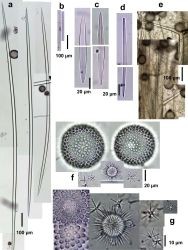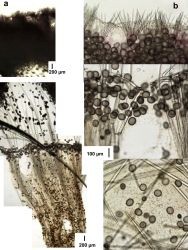yellow
green
orange
cinnamon-tan
spherical
hard
Bahamas
Geodia aff. gibberosa sp.4-"melon"
-
![<i>Geodia aff. gibberosa</i> sp.4-"melon" <br />[Bahamas, Plana Cays]](mini/00073/01618.jpg)
Species: Geodia aff. gibberosa sp.4-"melon" View Image Details Location: Bahamas, Plana Cays Photographer: Tse-Lyn Loh -
![<i>Geodia aff. gibberosa</i> sp.4-"melon" <br />[Bahamas, Plana Cays]](mini/00073/01619.jpg)
Species: Geodia aff. gibberosa sp.4-"melon" View Image Details Location: Bahamas, Plana Cays Photographer: Tse-Lyn Loh -
![<i>Geodia aff. gibberosa</i> sp.4-"melon" <br />[Bahamas, Plana Cays]](mini/00119/01786.jpg)
Species: Geodia aff. gibberosa sp.4-"melon" View Image Details Location: Bahamas, Plana Cays Photographer: Joseph Pawlik -
![<i>Geodia aff. gibberosa</i> sp.4-"melon" <br />[Bahamas, Plana Cays]](mini/00119/01790.jpg)
Species: Geodia aff. gibberosa sp.4-"melon" View Image Details Location: Bahamas, Plana Cays Photographer: Joseph Pawlik
Description: Spherical to ellipsoid in shape, hanging from reef cave walls and roofs, up to 30-50 cm tall and 20-30 cm in diameter. There is a central circular to elliptical or keyholed, well rimmed depression where oscules are grouped in a concave plate. Surface is even, but rather regularly perforated by shallow, probably inhalant, depressions, ca. 2-3 mm in diameter; surface is generally clean and could be shiny, but it is usually covered in low density by what appear to be hydroids. Color is cinnamon-tan to greenish gray; the interior is cream. Consistency is very hard and difficult to cut owing to its leathery cortex; the interior is softer. The peripheral skeleton from exterior to interior is conformed first by a cortex of densely packed sterraster microscleres, up to 2.5 mm in thickness, traversed horizontally and vertically by canals, 25-35 µm in diameter. The pinacoderm is stretched above the cortex, being heavily embedded by the smaller category of aster microscleres and traversed by bouquets of the smaller category of anystrongyloxea-oxea II megascleres. Below the sterraster cortex there follows a 3 mm fibrous subcortex with a few scattered erect oxea I and sterrasters. Further below, there is a 250-500 µm-thick subcortical layer of sterrasters aligned with the cladomes of triaene megascleres, whose rhabds are pointed downwards. These triaenes occur in bundles, which together with oxea I, conform ascending 2-10 spicule tracts, 50-200 µm thick, more or less parallel to each other and separated some 600-1000 µm. In between tracts, there are abundant small oxea and anysostrongyloxea II and dispersed sterrasters and oxyasters, the latter embedded in the pinacoderm lining canals. Further inwards, the tracts are looser, with many spicules in confusion. Megasclere spicules in three types: (1) Oxea I, slightly curved, usually hastate, stout, with both ends acute, generally very long, 1450-2375 µm long and 18.7-32.5 µm wide. (2) Anysostrongyloxea II (a few fully oxea), slightly curved, with one end narrower and blunt and the other acute, forming the superficial bouquets but also interspersed in the choanosome, 150-320 µm long and 6.2-7.0 µm wide; there appear not to be intermediate sizes in between I and II diactine megasclere categories. (3) Plagiotriaenes, with short to long, stout and usually acute clades, 40-300 µm long and 10-25 µm wide at the base; length of rhabds could not be ascertained, being 10-30 µm wide at the base. Microscleres in two basic types: (1) Sterrasters, round, relatively large, 75-80 µm in diameter, with spined rosettes up to about 7 µm in diameter; developmental stages are smaller balls surrounded by thin needles to larger ones surrounded by conical stout conical spines from which the rosettes would develop. (2) Asters in two categories (difficult to discern under light microscopy), with spined rays; large oxyasters with 6-8 slender rays, 15-25 µm in total diameter; smaller strongyl- or oxyasters, up to 5.5 µm in total diameter.
Notes: This species lives in deep reef overhangs and caves. We initially incorrectly identified this species as G. corticostylifera, also pictured here, on the grounds of the style-like anysostrongyloxea II in the cortex. In the ongoing morphological and molecular revision of Geodia by Paco Cárdenas (Uppsala University, Sweden) our material seems to fall in the G. gibberosa species complex and, following his system, we have named this one as Geodia aff. gibberosa sp.5, dubbing it with the nickname "melon" for the resemblance of its shape to this fruit. G. megastrella Carter, 1876 redescribed by Silva (2002) seems to conform in part to our material, but further comparisons are needed, as this name is from the E. Atlantic and seems to also conform a species complex (P. Cárdenas, pers. comm.). We initially also combined the material of this species with what is now being pictured here as G. aff, gibberosa sp.4, but analysis by P. Cárdenas showed it to be different. The latter forms mounds instead of spheres or ellipsoids, and has some styloid to strongyloid derivations of the oxea I megascleres.
-

Spicule Images: a) Oxeas I; b) anysostrongyloxeas II, c) enlarged ends of oxeas I; d) enlargement of an anysostrongyloxea II; e) plagiotriaenes; f) microscleres (sterrasters, developed and developing; spined asters in two types, oxyasters and strongyl- or oxyasters); g) enlargement of microscleres (rossettes of sterrasters on the left). Sample from the Bahamas.
View Source Specimen -

Tissue Images: a) Perpendicular section of the body (surface above; the dark curved line crossing the lower panel is a fracture on the slide cover slip glass); b) magnification at the surface (above), subsurface (mid) and choanosome (lower) showing sterrasters and the aligned cladomes of triaenes; the lower panel is a magnification of the choanosome. Sample from the Bahamas.
View Source Specimen
